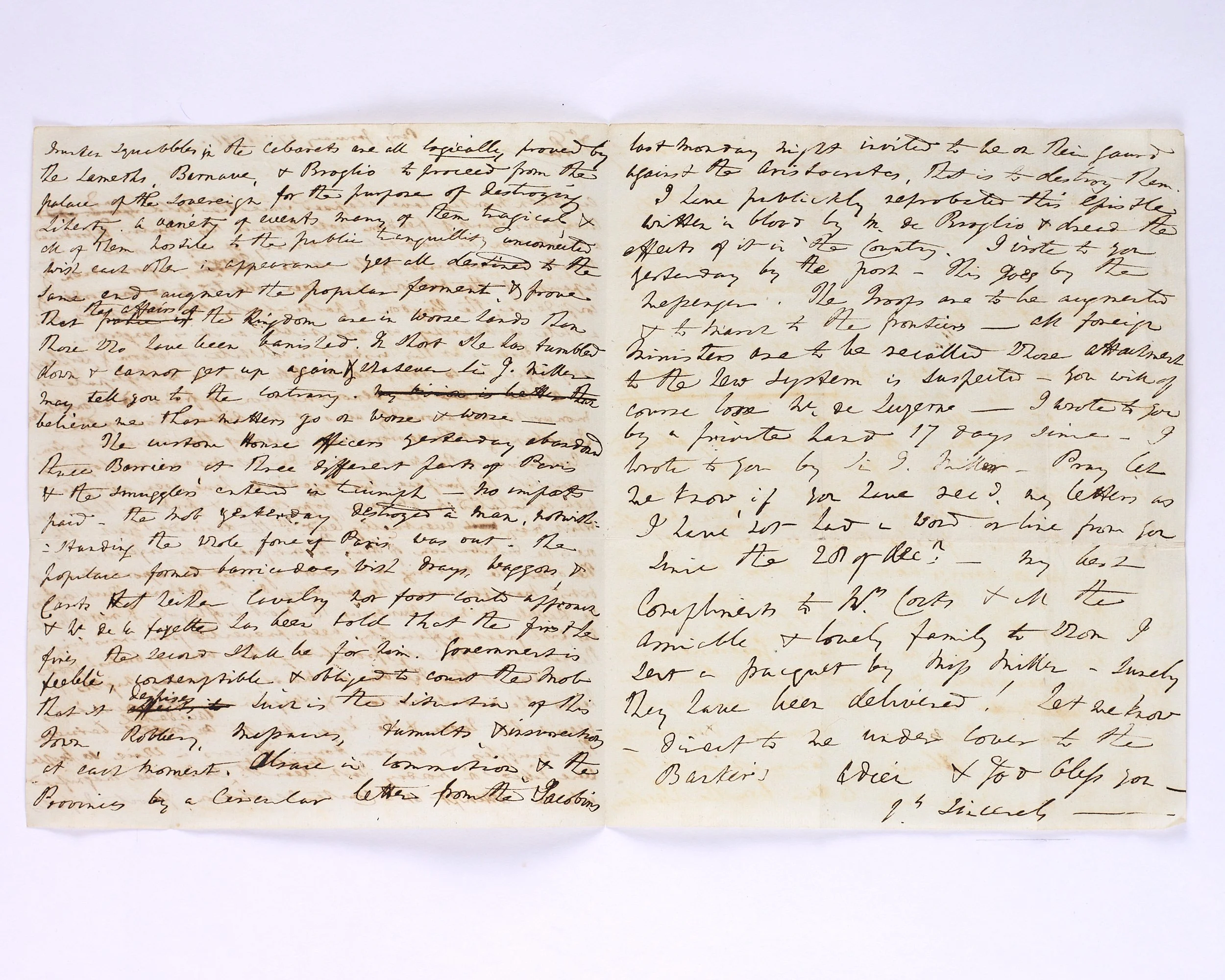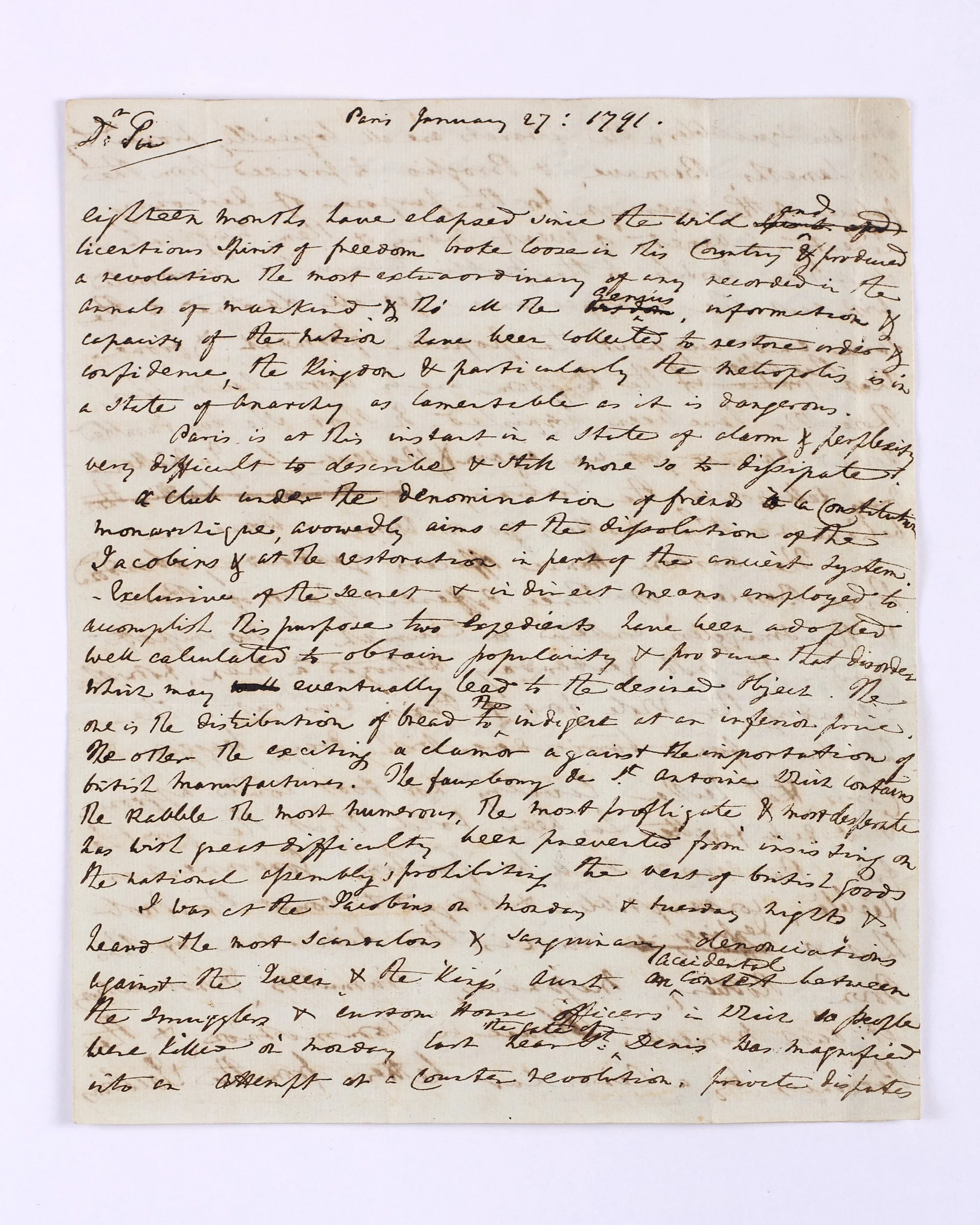 Image 1 of 2
Image 1 of 2

 Image 2 of 2
Image 2 of 2



Letter written by a British spy during the French Revolution
[FRENCH REVOLUTION]; [William Augustus MILES?]
Letter written by a British spy during the French Revolution
Paris: 1791
A three-sided manuscript letter (18.5 x 23cm approx folded, 37.5 x 23cm unfolded), written in ink by an unknown hand and dated January 27th 1791 to the upper edge of the first page; folded multiple times, likely for ease of transportation or to mask its discovery to England; the writing, which begins in a neat, sloping hand, becomes more erratic as time goes on, doubling in size before the final line and signed simply ‘Yours sincerely’, with no name given; some words or sentences crossed out with corrections, occasionally, given above; aside from the creasing fine; a remarkable survival.
An autograph letter seemingly from a British agent, who provides a detailed eyewitness account of the tumultuous events unfolding in revolutionary Paris on the 27th January 1791.
“Eighteen months have elapsed since the wild and licentious spirit of freedom broke loose in this country and produced a revolution”, the letter begins, “The most extraordinary of any recorded in the annals of mankind”. It goes on to describe the metropolis which is “in a state of anarchy as lamentable as it is dangerous… Paris is at this instant in a state of alarm and perplexity” and the mob, who “formed barricades with drays, waggons and carts”. Of particular note are the references to La Constitution Monarchique (which was eventually accepted by King Louis XVI in September of that year), the counter-revolutionary breakouts, the epistle ‘written in blood’ of Broglie and his attempts to ‘destroy liberty’ and Lafayette (who was at the time attempting to maintain order within the country). Two references are made to a ‘G. Millar’, who seems to be an acquaintance of the letter writer and to have played a part in getting the letters out of the country - though unsuccessfully, as “I have not had a word or line…since 20 of Dec”. This is perhaps unsurprising for a series of letters apparently sent in secret to London during a time of such great upheaval.
While events in Paris during 1790 and 1791 were relatively calm in relation to the years surrounding them, the city was nonetheless increasingly divided, partly due to the actions Jacobin club (mentioned here by way of a “circular letter from the Jacobians last Monday…invites to be on their guard against the aristocrats”) By June disorder had escalated further, leading King Louis XVI on his famous Flight to Varennes, in which he and his family unsuccessfully attempted to leave Paris for Montmédy.
Research suggests that the writer may be William Augustus Miles (1753-1817) a political writer and British agent who served in the West Indies during the American Revolutionary War, and was later a prisoner of war in St. Lucia. From 1784, he became a secret agent to the Prime Minister William Pitt, who first sent him to Paris in July 1790. There, he made a series of important connections within the French government, and even became a member of the Jacobin club. He left Paris in April 1791.
A remarkable piece of historical first-hand evidence recounting some of the early years of the Revolution as they happened in front of the writer’s very eyes.
[FRENCH REVOLUTION]; [William Augustus MILES?]
Letter written by a British spy during the French Revolution
Paris: 1791
A three-sided manuscript letter (18.5 x 23cm approx folded, 37.5 x 23cm unfolded), written in ink by an unknown hand and dated January 27th 1791 to the upper edge of the first page; folded multiple times, likely for ease of transportation or to mask its discovery to England; the writing, which begins in a neat, sloping hand, becomes more erratic as time goes on, doubling in size before the final line and signed simply ‘Yours sincerely’, with no name given; some words or sentences crossed out with corrections, occasionally, given above; aside from the creasing fine; a remarkable survival.
An autograph letter seemingly from a British agent, who provides a detailed eyewitness account of the tumultuous events unfolding in revolutionary Paris on the 27th January 1791.
“Eighteen months have elapsed since the wild and licentious spirit of freedom broke loose in this country and produced a revolution”, the letter begins, “The most extraordinary of any recorded in the annals of mankind”. It goes on to describe the metropolis which is “in a state of anarchy as lamentable as it is dangerous… Paris is at this instant in a state of alarm and perplexity” and the mob, who “formed barricades with drays, waggons and carts”. Of particular note are the references to La Constitution Monarchique (which was eventually accepted by King Louis XVI in September of that year), the counter-revolutionary breakouts, the epistle ‘written in blood’ of Broglie and his attempts to ‘destroy liberty’ and Lafayette (who was at the time attempting to maintain order within the country). Two references are made to a ‘G. Millar’, who seems to be an acquaintance of the letter writer and to have played a part in getting the letters out of the country - though unsuccessfully, as “I have not had a word or line…since 20 of Dec”. This is perhaps unsurprising for a series of letters apparently sent in secret to London during a time of such great upheaval.
While events in Paris during 1790 and 1791 were relatively calm in relation to the years surrounding them, the city was nonetheless increasingly divided, partly due to the actions Jacobin club (mentioned here by way of a “circular letter from the Jacobians last Monday…invites to be on their guard against the aristocrats”) By June disorder had escalated further, leading King Louis XVI on his famous Flight to Varennes, in which he and his family unsuccessfully attempted to leave Paris for Montmédy.
Research suggests that the writer may be William Augustus Miles (1753-1817) a political writer and British agent who served in the West Indies during the American Revolutionary War, and was later a prisoner of war in St. Lucia. From 1784, he became a secret agent to the Prime Minister William Pitt, who first sent him to Paris in July 1790. There, he made a series of important connections within the French government, and even became a member of the Jacobin club. He left Paris in April 1791.
A remarkable piece of historical first-hand evidence recounting some of the early years of the Revolution as they happened in front of the writer’s very eyes.

